You are here
Why Long-Term Debt Matters
In recent weeks, some commentators have urged policymakers to move away from the fiscal policy debate to other issues, such as immigration reform and foreign policy. Reports of “good news” on the fiscal front are being used to suggest that it’s time to move on — improvements in the economy, a better 10-year budget outlook, and slower healthcare cost growth have allegedly reduced the need for a comprehensive budget deal.
Yet the stark reality is that the fundamental fiscal challenge of the United States remains: America is on an unsustainable fiscal path that threatens its future economy and role in the world. America has a serious long-term debt problem that hasn’t been solved, and Washington needs to act soon.
HOW BIG IS THE LONG-TERM DEBT PROBLEM?
Under current policies, publicly held debt is projected to increase from 73 percent of gross domestic product (GDP) in 2012 to 83 percent in 2023. That’s a historically high level, but the even more dangerous fact is that over the next 30 years, publicly held debt is expected to rise to over 200 percent of GDP. It’s this long-term debt trend that poses the biggest threat to America’s economic future.
The retirement of the Baby Boomers and rising healthcare costs will be the key contributors to future debt. In 2043, 95 million people will be receiving Social Security benefits, up from 58 million today. And even if the cost of healthcare rises somewhat less rapidly than previously assumed, it will still drive spending and debt to unprecedented levels.
- Debt will rise to 83 percent of GDP by the end of this decade — that is more than double the postwar average.
- Over the following two decades (11-30 years from now), debt will rise to over 200 percent of GDP.
- The number of people receiving Social Security benefits will swell from 58 million today to 95 million in 2043.
- Even if health costs per beneficiary don’t grow faster than GDP per person after 2023, federal debt will still climb above 200 percent of GDP by 2045.
It’s true that recent budget reforms have improved the near term outlook, but they have failed to address these structural budget challenges because the reforms did not sufficiently address the fundamental drivers of our long-term debt. Unfortunately, we still are on an unsustainable and dangerous debt path.
Despite policy changes and slowing health care costs, federal debt is still projected to climb to unsustainable levels
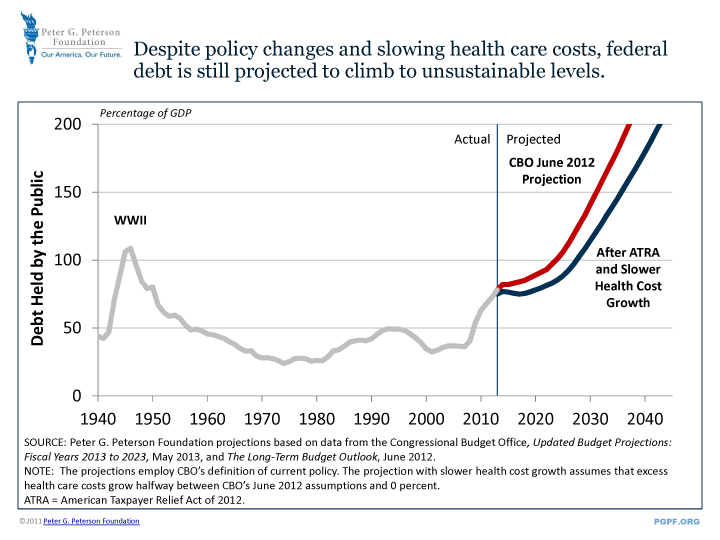
WHY LONG-TERM DEBT MATTERS
While there is no "magic number" at which debt itself begins to hurt economic growth, almost no economist thinks the United States could sustain a debt burden rising to those levels without cost or consequence.
A major reason is the interest costs that come with debt. While the Administration and Congress have worked in recent years to reduce the deficits over the next 10 years, the fact remains that we will still spend more than $5 trillion in interest payments alone over the next ten years. By 2040, interest costs will account for more than one-quarter of total spending if current policies are continued. Looking even further out, on our current unsustainable path, interest consumes 100 percent of the entire federal revenues!
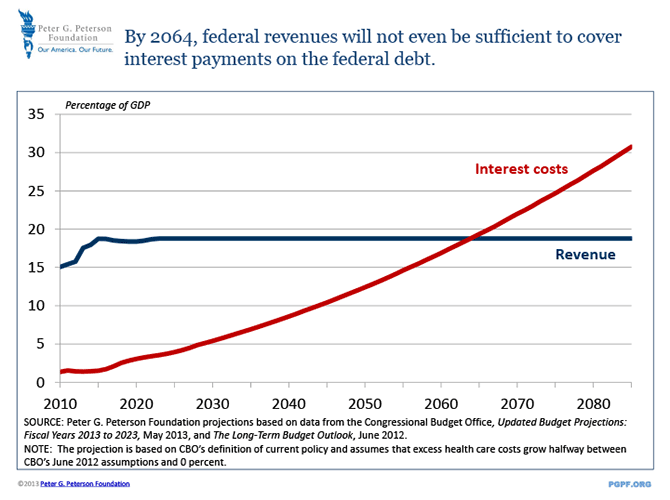
Devoting more resources to interest payments would leave the federal government with fewer resources to invest in areas such as education and skills training, infrastructure, and research and development. Furthermore, as the federal government issues more debt and soaks up more capital from markets, the private sector has access to less capital, diminishing private investment in the economy. With this high of a debt burden, the economy is left with less fuel for innovation, entrepreneurship, growth, and job creation.
- Over the next ten years, the federal government will spend more than $5 trillion on interest.
- By 2043, interest payments are projected to total almost 10 percent of GDP. That’s more than we spend today on Social Security and Medicare combined.
WHY LONG-TERM DEBT MATTERS TO OLDER AMERICANS AND OUR VULNERABLE CITIZENS
If policymakers fail to address our long-term debt, every government program could be in jeopardy. In the event of a fiscal crisis, we may have no choice but to cut important programs to be able to pay our debts and remain solvent. Older Americans and other people who receive federal benefits and safety net programs — including Social Security, Medicare, and Medicaid — are in a particularly precarious position given how much they rely on these vital programs. With Medicare, Medicaid, defense, and most other government functions competing for potentially limited dollars, all programs would constantly face the budget ax, leaving no safety net expenditure, investment, or critical government activity secure.
The most recent Social Security trustee reports say that trust funds will be exhausted in 2033 — just 20 years from today. Medicare’s finances are even more troubling — Medicare’s trust fund is expected to run out of money in 2026.
Some suggest that that means we don’t have to deal with this now ("We have plenty of time!")
The truth is that if we don’t act before the trust funds run dry, Social Security benefits will have to be cut all at once by 23 percent. And even with the recent decline in the rate of growth in healthcare costs, this area still represents the fastest growing government program, due to both the growing number of elderly, as well as growing costs.
If we act now, we can make gradual and fair changes to our retirement programs that don’t exhaust the trust funds, that give people time to prepare, and that ensure that we take care of the most vulnerable in our population. So it’s not just today’s retirees who have a stake in the program’s future — every current worker has a direct stake in making sure we keep Social Security and Medicare solvent.
- Social Security’s trust funds will be exhausted in 2033 — just twenty years from now.
- Further, the money in so-called trust funds has already been spent, so they hold only government IOUs that will increase federal borrowing as they are cashed in to pay benefits, adding $2.7 trillion to outstanding public debt.
- If the system isn’t reformed, Social Security will be forced to cut benefits for every retiree by 23 percent when the trust funds are depleted.
- Spending on major healthcare programs will climb by more than one-third between now and 2026, which is also when Medicare’s trust fund will be exhausted.
- In 2026, the gap between federal spending and revenues could be at least 7 percent of GDP — roughly $1.2 trillion in today’s dollars — with no improvement in sight.
The baby boom generation will boost Medicare enrollment
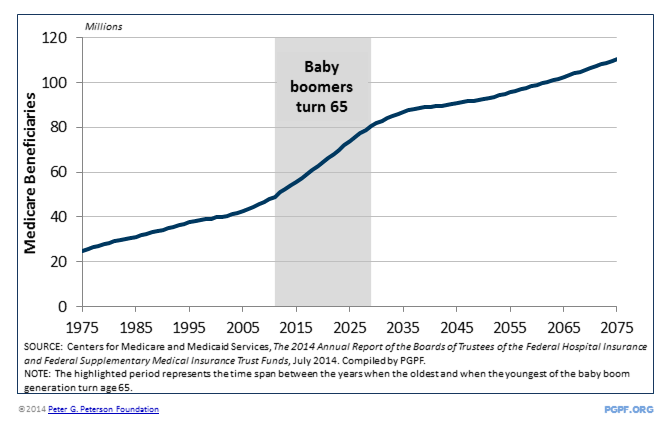
SOURCE: Data from the Center for Medicare and Medicaid Services, 2013 Medicare Trustees’ Report, May 2013. Compiled by PGPF.
NOTE: The highlighted period above covers the time between when the oldest of the generation and the youngest of the generation become eligible for Medicare at age 65.
Healthcare is the major driver of the projected federal spending growth over the long term
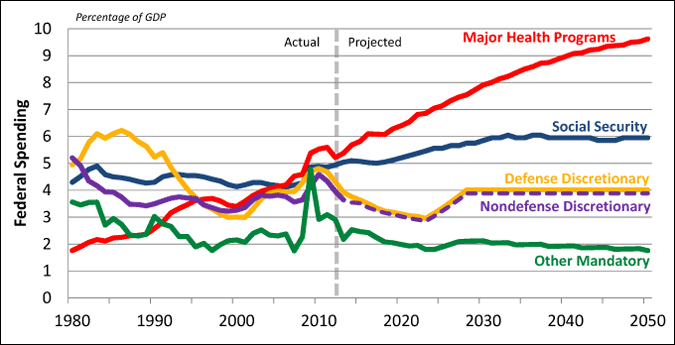
SOURCE: Peter G. Peterson Foundation projections based on data from the Congressional Budget Office, Updated Budget Projections: Fiscal Years 2013 to 2023, May 2013, and The Long-Term Budget Outlook, June 2012.
NOTE: Projections are based on CBO’s definition of current policy. The projections assume that excess health care costs grow halfway between CBO’s June 2012 assumptions and 0 percent.
WHY LONG-TERM DEBT MATTERS TO YOUNG AMERICANS
To many young people, the national debt and retirement may seem like an abstract concern that is far away. But younger Americans actually have the most to gain, or lose, from how we address our fiscal challenges.
If we fail to address our structural deficits, the next generation will be the one that gets stuck with most of the fallout. After all, today’s students will be tomorrow’s workers and eventually, retirees. They will face the higher tax burdens needed to fund the government and its interest obligations. And if we have to make drastic changes to our retirement programs, future benefits may not be sufficient for future generations of retirees.
In addition, a federal government that is saddled with debt will have a much harder time investing in the next generation. On our current path, we will spend much more on interest (the past) than we do on our future, and this would undoubtedly harm the future economy that the next generation will enter into.
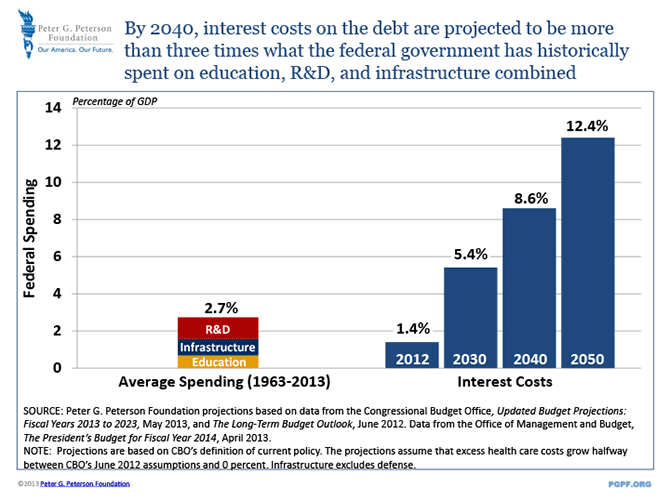
WHY ELECTED LEADERS SHOULD SOLVE OUR LONG-TERM DEBT PROBLEM NOW
Our fundamental long-term fiscal challenges relate primarily to demographic and other trends that occur over the next few decades. So while some claim that this means we can deal with them later, it’s essential that we act soon.
First of all, if we are going to make changes to our vital retirement programs, we must give people time to prepare. It’s simply not fair to make sudden changes to programs that are vital to many elderly Americans. For example, many proposed reforms do not impact anyone older than 55. But if we wait too long, it may be harder to insulate people close to retirement.
America has a serious long-term debt problem that hasn’t been solved, and Washington needs to act soon.
Second, if we act soon, we can make changes more gradually. By acting before our debt and interest costs rise too high, we can prevent even bigger changes that would be required to fund a staggering debt level. And deciding on a long-term plan now enables us to spread the impact over a longer period of time.
In addition, acting now would boost global confidence in America. For the first time, in 2011, America’s debt was actually downgraded because people were not confident about our ability to solve our fiscal challenges. That served to reduce business confidence and hurt our economy. If we were to actually get our fiscal house in order, we could re-ignite confidence in America, and not only improve our long-term economy, but boost today’s recovery too.
And there are those who claim that now is not the right time to act, because of the fragile recovery. The truth is that the changes in taxes and spending don’t have to be implemented immediately. Enacting a plan now, that goes into effect when our economy is stronger, is the best way to show that we are serious about addressing these challenges, without engaging in unwise austerity measures that could harm the recovery in the near term.
No American wants a future in which our economy is saddled with debt, starved of investment, and struggling to grow. By taking action now, Congress and the President can lay a foundation for more investment, stronger economic growth, and a more secure safety net for future generations. It’s time to concentrate on economic growth, job creation, and long-term debt reduction. Policymakers can help today’s economy by agreeing on a comprehensive plan to put long-term debt on a sustainable, declining path. The longer we wait, the more difficult it will be.
Our long-term fiscal challenges are clear, and solutions are available. Washington should agree on a long-term plan now.

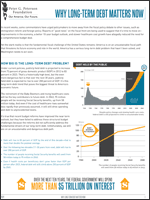 Download the PDF
Download the PDF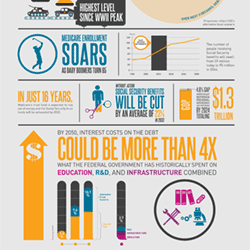 See the infographic
See the infographic